Novodevichiy
Convent
This
16-17th century complex of 15 buildings, surmounted by golden domes,
is one of the oldest religious complexes in Moscow. It was here that women from
the royal family and top-ranking boyar families took the veil, thereby closely
linking its history with the life of the Russian state from the 16th
to early 18th centuries.
Pictures
by Joost Lemmens
The Novodevichiy Convent, also known as the Convent of the Smolensk Icon of
Our Lady, was founded in 1524 by Grand Prince Vasily III to commemorate the
recapture of the city of Smolensk from the Lithuanians. It was called
Novodevichiy (“New Maidens”) because it was situated not far from the older 14th
century St. Alexei convent.
The convent, built as a fortress at the intersection of three crossings of
the Moskva River, became an important component of the capital's southern
defence belt. It played an important part in the struggle against the Tatar
conquerors and the Polish invaders. In 1591, when the Crimean Khan Kazy Girei
tried to cross the Moskva River, the convent's cannon compelled the enemy to
retreat. In 1612, the troops led by Dmitri Pozharsky defeated Hetman
Chodkiewiez's detachments here.
Ravaged during the Times of Troubles, it was rebuilt in the 1680's by the
Regent Sofia.
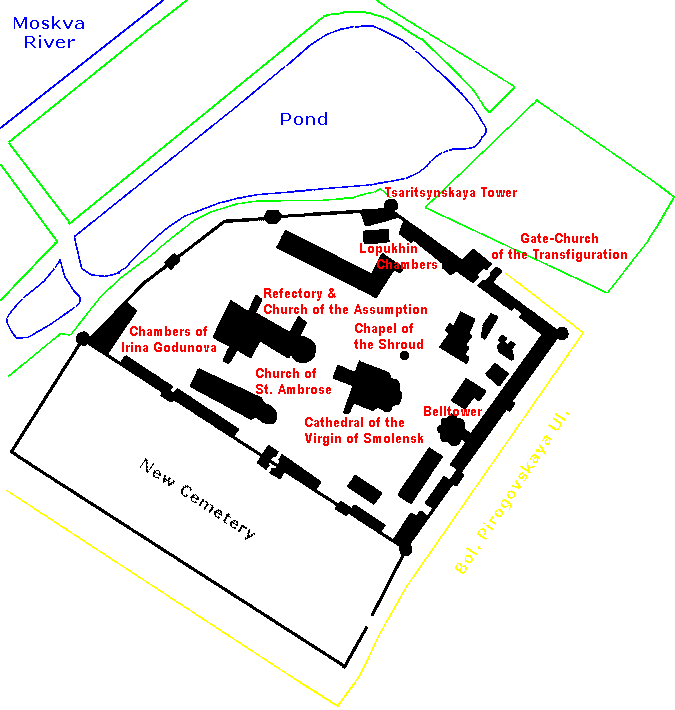
In 1702 Peter I issued an edict, which stipulated that the gates of the
Women's Convents must always be closed, their watchmen should be old people and
men must never visit the convents. Since 1724 an orphanage was opened at the
monastery, and children were taught weaving laces and spinning threads.
In 1812, shortly before the retreat of the French from Moscow, Napoleon
ordered the convent to be blown up. Trenches were dug and filled with powder
kegs. The convent was saved by the valiant Sister Sana, the cloister's
treasurer, who managed to extinguish the fuses.
Later, in 1875, a new school for orphans was opened. Graduating from that
school, children became nursemaids and servants. In 1917 the school was
closed.
|
Situated near the eastern wall, the 72-meter Bell Tower rivals the
famous Bell Tower of Ivan the Great in the Kremlin in its beauty. Elegant
and highly decorative it was erected in 1689-1690, and consists of six
octagonal stepped tiers crowned with a gilt cupola. |
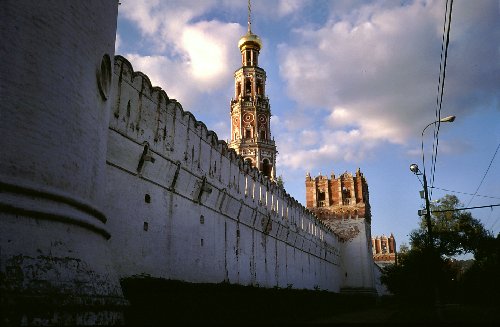 |
|
Eastern Wall & Bell
Tower
|
|
|
The brick walls were reconstructed at the end of the 17th century, when
the convent was refurbished by the regent Sofia (1657-1704), Peter the
Great's half-sister. After the unsuccessful Streltsy rebellion of 1689 he
had her locked up in the convent's Chamber Prison, while the three
ringleaders and 195 other rebels were hanged outside her window. |
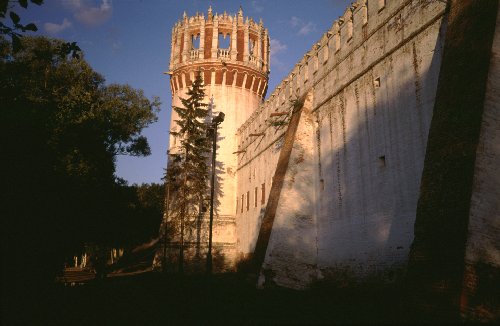 |
|
Tsaritsynskaya
Tower
|
|
|
Surrounded by a massive brick wall with swallow-tailed battlements and
twelve bastions, the convent is entered via the Gate-Church of the
Transfiguration. |
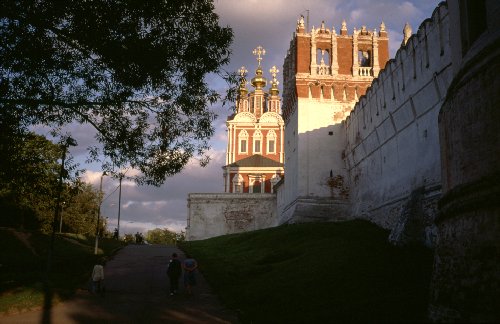 |
|
Gate Church of the
Transfiguration
|
|
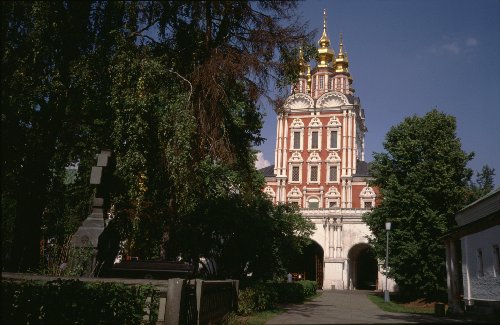 |
Built 1687-89 at the behest of the Regent Sofia, it is a baroque tower
with five gilded domes. |
|
Gate Church of the Transfiguration
|
|
|
Just inside are the Lopukhin Chambers, also built under Regent
Sofia. It is named after the first wife of Peter the Great, Evdokiya
Lopukhina, who took the veil at the Suzdal' Pokrovsky Convent, but later moved
to Novodevichiy by edict of her grandson Peter II. |
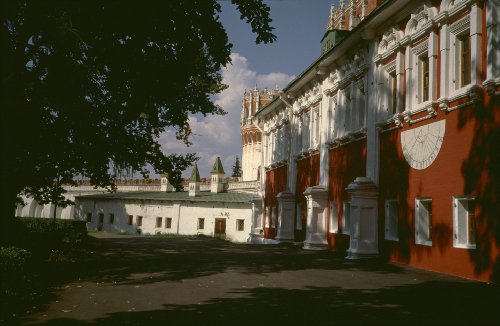 |
|
Lopukhin Chambers
|
|
The Cathedral of the Virgin of Smolensk (1524-1525) is the oldest building of
the Novodevichiy Convent. It is strongly influenced by the cathedral of the
Archangel Michael in the Kremlin, built in 1505-1508 by the Italian Alevis'
Fryazin the Younger or Novi, from Milan.
|
In 1598 it was restored by Boris Godunov, who had lived in the
Monastery for a while. It was here that Patriarch Job asked him to become
Tsar of all Russia. |
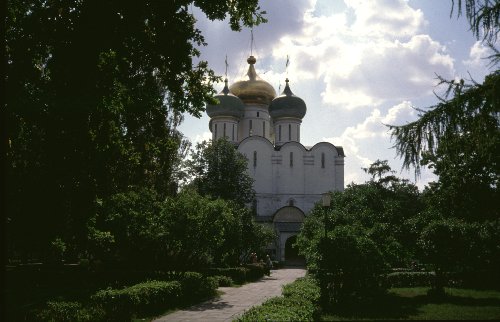 |
|
Cathedral of the Virgin of
Smolensk
|
|
|
The Uspenskaya (Assumption) church was built in 1685-87, also at the
behest of Regent Sofia. |
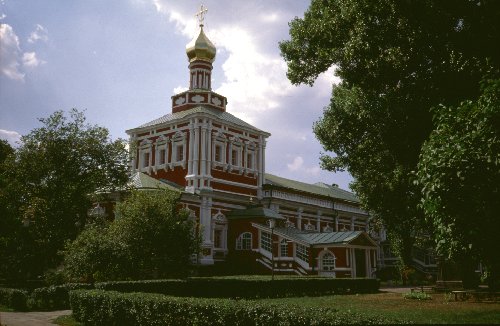 |
|
Refectory and Church of the
Assumption
|
|
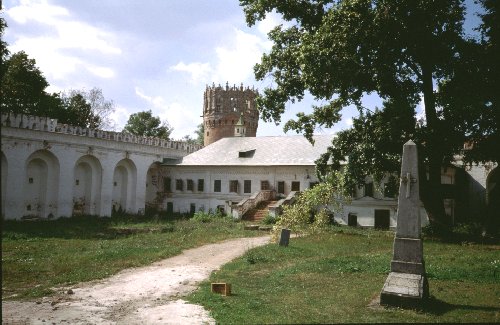 |
The sister of Boris Godunov, Irina Godunova retired here in 1598 after
the death of her feeble-minded husband Tsar Fjodor Iovannovich, the last
of the Rurik Dinasty. |
|
Chambers of Irina Godunova
|
|
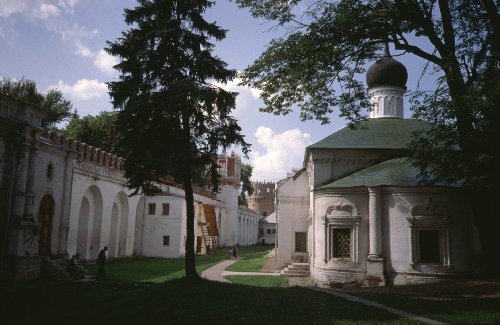 |
One of the older structures from the time of the Convents foundation is
the low, all-white Church of Saint Ambrose. |
|
Church of Saint Ambrose
|
|
|
As soon as the convent was founded, a cemetery was opened on its
grounds, which subsequently became a traditional burial place for the
church dignitaries and feudal lords of Moscow and later on, in the 19th
century, of the intelligentsia and merchants. |
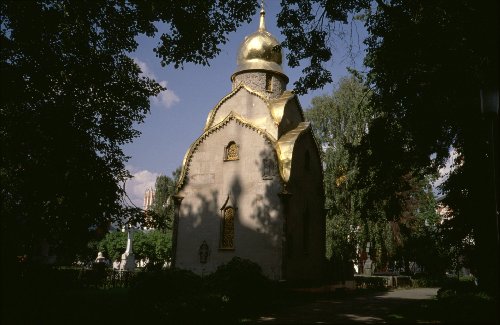 |
|
Chapel of the
Shroud
|
|
In 1898, the so-called New Cemetery was established behind the south wall of
the convent. Surrounded by a wall in 1898-1904, it became the most venerated
cemetery in Moscow.
In 1922 the convent was closed, and the buildings turned into a museum, such
as the Museum of Women's Emancipation which was opened here. After 1945 the
Cathedral was returned to the Church.
Novodevichiy Convent Museum - Muzey "Novodevichiy monastyr" ( filial GIM)
Branch of State Historical Museum;
Wonderful relics of 16th and 17th C culture, ancient icons, tapestries & frescoes.
Novodevichiy pr-d, 1.
Excursions:246-85-26
Director:.246-22-01
Su, Mo, We-Sa 10-17;
Sportivnaya, Kropotkinskaya +Tram: 15, 5
Home |
Next Page: Krutitskoye Podvorye >>
Links
My
Other Pages:
Mail:










